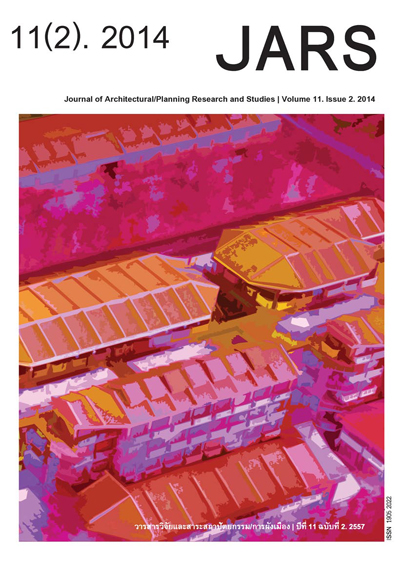The Study of the Design Process for Development and Conservation of China Town District: A Case Study of Weangnakonkasem Community
Main Article Content
Abstract
The development of public transportation in urban areas to the rail system and the construction project of subway through the center of Bangkok have created an adverse impact to Chinatown, the old commercial areas of Bangkok. Weangnakonkasem Community is one of the examples of the areas receiving the impact. The construction of MRT-blue line through Wang Burapha areas caused the landlord to have an idea to sell the land in Weangnakonkasem since the area is within 500 m from the MRT station, and so receive an encouragement for intense economic development. This idea caused the conflict between landlord and leaseholders living in Weangnakonkasem since this area is an old commercial area where Chinese people have settled down and inhabited for at least four generations. To conserve the place where their ancestors have started and pass on their culture to the next generation, the inhabitants in Weangnakonkasem have aggregated the money and requested to buy the land from the landlord, and discussed within the community to find the way to develop the land. This research is an action research having an objective to study the design procedure for land development that can retain the cultural value of Weangnakonkasem Community using participatory process. The researcher used culture, study visit and knowledge exchange as the tools to work with the community. The project started by brainstorming the ideas from community, aggregating information, analyzing the problems, finding the solution which finally leading to the procedure for land development design. However, while researcher was working together with Weangnakonkasem Community, the land has been sold to the new landlord. Consequently, the land development plan of Weangnakonkasem Community needed to be stopped without a chance to achieve the objective. The researcher had a chance to present the initial development design to the community, listen to their opinions and obtain a conclusion. The important issues toward the development and conservation of Weangnakonkasem Community that have been found are: (1) the identity and the importance of old town community toward the spirit of the city; (2) the important factors for the success of the project, and (3) the important process and project procedure that can lead to the success of the project.
Downloads
Article Details

This work is licensed under a Creative Commons Attribution-NonCommercial-NoDerivatives 4.0 International License.
All material is licensed under the terms of the Creative Commons Attribution 4.0 International (CC-BY-NC-ND 4.0) License, unless otherwise stated. As such, authors are free to share, copy, and redistribute the material in any medium or format. The authors must give appropriate credit, provide a link to the license, and indicate if changes were made. The authors may do so in any reasonable manner, but not in any way that suggests the licensor endorses you or your use. The authors may not use the material for commercial purposes. If the authors remix, transform, or build upon the material, they may not distribute the modified material, unless permission is obtained from JARS. Final, accepted versions of the paper may be posted on third party repositories, provided appropriate acknowledgement to the original source is clearly noted.
References
Arnstein, S. R. (1969). A ladder of citizen participation. Journal of the American Planning Association, 35(4), 6.
Bordenave, J. D. (1994). Participative communication as a part of building the participative society. In S. A. White, K. S. Nair & J. Ascroft, Participatory communication: Working for change and development. CA: SAGE.
Bunyapravitr, T. (2009). การเติบโตอย่างชาญฉลาด [Smart growth]. Retrieved from http://www.facebook.com/SmartGrowthThailand:2552
Issarathammanoon, W. (2000). การศึกษาเพื่อจัดทำโครงการอนุรักษ์และฟื้นฟู ย่านสามแพร่ง [A study for the preservation and renewal program of Sam Prang District]. Master of Architecture Thesis, Chulalongkorn University, Bangkok, Thailand.
Kangwanpoom, C. (2014). ความสําคัญของกระบวนการมีส่วนร่วมในการพัฒนาย่านเก่าของเมือง: กรณีศึกษา พื้นที่บริเวณ สถานีรถไฟฟ้าใต้ดินวัดมังกรกมลาวาส [Importance of Participatory Process in Urban Regeneration: Case Study of Wat Mangkorn Kammalawat MRT Station’s Surounding Areas]. Journal of Architecture/Planning Research and Studies, 11(1), 21-36
Konisranukul, W. (2007). หลักการสําคัญซึ่งทําให้การออกแบบชุมชนเมืองประสบความสําเร็จ [The substantive urban design considerations: Priorties for creating successful places]. Journal of Architecture/Planning Research and Studies, 5(2), 91-107.
Kraiwaas, K. (1995). อิทธิพลของศูนย์การค้าต่อการเปลี่ยนแปลงของเมืองเชียงใหม่ [The influence of shopping center on Chiangmai city]. Master of Urban and Regional Planning Thesis, Chulalongkorn University, Bangkok, Thailand.
Leerakul, A. (1997). Concept in design and analysis. ASA – Journal of Architecture, 5.40, 54.
Promsakha Na Sakonnakon, P. (2004). การเปลี่ยนแปลงรูปแบบที่อยู่อาศัยของชุมชนดั้งเดิมในกรุงรัตนโกสินทร์ : กรณีศึกษา ชุมชนตรอกศิลป์-ตรอกตึกดิน [Transformation of housing pattern in old community in Krung Rattanakosin: A case study of Trok Sin-Trok Tuk Din community]. Master of Housing Development Thesis, Chulalongkorn University, Bangkok, Thailand.
Sinnthawanurak, J. (1988). แนวทางการวางแผนการใช้ที่ดินเพื่อการค้า เขตปทุมวัน [A guideline for the commercial landuse planning of pathum wan district]. Master of Urban and Regional Planning Thesis, Chulalongkorn University, Bangkok, Thailand.
Singhalm, A. (2001). Facilitating community participation through communication. New York: UNICEF.
Srichuae, S. (1997). แนวทางการวางแผนพัฒนาย่านการค้าหลักในเขตชั้นกลางของกรุงเทพมหานคร: กรณีศึกษา เขตบางกะปิ [The development planning for major commercial districts in the intermediate area of Bangkok: A case study of Bangkapi district]. Master of Urban and Regional Planning Thesis, Chulalongkorn University, Bangkok, Thailand.
Sujchaya, C. (2009). การอนุรักษ์เมือง [City conservation]. Bangkok: Amarin Printing and Publishing.
UNESCO. (2003). The convention for the safeguarding of intangible cultural heritage. France: Author.
Thai Urbanism Association. (2009). โครงการศึกษาแนวทางการพัฒนาเมือง การจัดรูปแบบองค์กรการพัฒนาเมืองที่เหมาะสม และการยกร่างกฎหมายการพัฒนาเมือง [Study project of city development guideline management of organization system, The proper of city development and law drafting of city development]. Bangkok: Author.
White, S. A., Nair, K. S. & Ascroft, J. R. (1994). Participatory communication working for change and development. New Delhi: SAGE.


